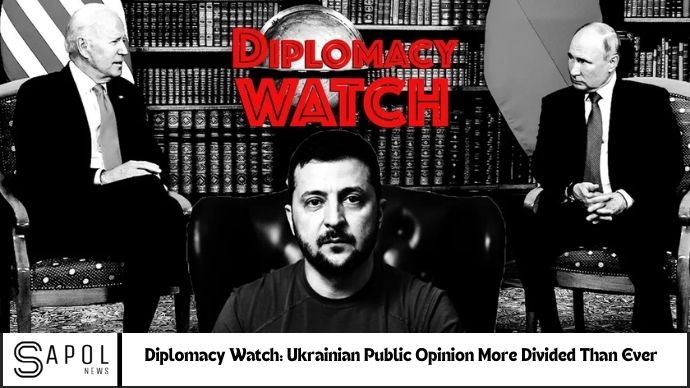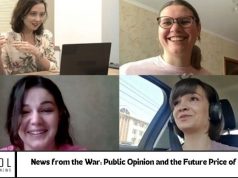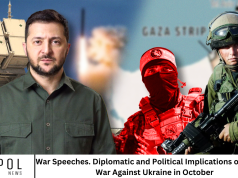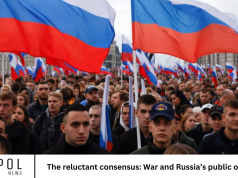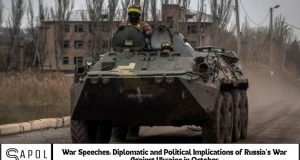Introduction: A Divided Nation – Why Are Ukrainians Split on Diplomacy?
Diplomacy Watch: Ukrainian Public Opinion More Divided Than Ever This week, The New York Times reported from Kyiv, shedding light on the evolving public opinion in Ukraine regarding the war’s resolution. The article highlighted a growing shift in sentiment, revealing that Ukrainians are more divided than ever on how to end the war. This division, it suggests, is far more complex than traditional media portrayals have often implied.
The Times described the trend as “a palpable shift in the conversation around peace talks—from a firm stance of no-deal-not-ever to a more open, maybe-compromise-at-some-point approach.”
As noted in recent editions of Diplomacy Watch, multiple surveys have shown that Ukrainian public opinion is moving toward the idea that the war may require a negotiated settlement to end. This shift has been captured in a series of polls, which demonstrate growing openness toward peace talks with Russia.
For example, ZN.ua, a leading Ukrainian online publication, recently conducted a survey showing that nearly 44% of Ukrainians now believe it’s time to begin official negotiations with Russia. This marks a significant increase from just 23% who held this view in a similar poll conducted a year ago.
In a separate poll published by the Kyiv International Institute of Sociology (KIIS), the number of Ukrainians willing to consider territorial concessions in exchange for peace tripled in the last year, rising from 10% to 32%.
However, as The Times points out, there remains considerable uncertainty about what a potential peace deal might look like. For instance, in the ZN.ua poll, 83% of respondents opposed Russian President Vladimir Putin’s publicly stated conditions for a ceasefire. Additionally, over 60% of Ukrainians stated they were unwilling to make concessions to Russia to secure a peace agreement.
The KIIS poll found that more than half of the respondents still believe Ukraine should not cede any territory to Russia, emphasizing the deep complexities surrounding a potential peace settlement.
Despite these disagreements on the details, the trend toward considering some form of compromise is undeniable. Mark Episkopos of the Quincy Institute (QI) highlighted this in The Nation in late June, arguing that understanding the complex nature of Ukrainian public opinion is crucial to ending the war. Episkopos warned against oversimplifying the situation, particularly by conflating the interests of the Ukrainian government with the broader views of the people. He stressed that continuing to ignore these growing divisions could hinder the development of a more realistic and humane strategy for resolving the conflict.
Among Ukrainian elites, while there have been no overt signs of dramatic change, there is growing evidence of a shift toward direct engagement with Russia. For example, Ukraine’s foreign minister recently visited China—the first such visit since the invasion—and invited Beijing’s top diplomat to visit Kyiv. Furthermore, President Volodymyr Zelensky has expressed interest in having Russia attend Ukraine’s next peace summit, though Moscow has yet to commit to participating.
In related diplomatic news, a recent Pew Research poll released in July revealed stark partisan divides in the U.S. regarding support for Ukraine. Among Democrats, 63% believe the U.S. has a responsibility to defend Ukraine, while only 36% of Republicans share this view. When asked about the level of U.S. support for Ukraine, a plurality of Democrats (36%) said it was “just right,” while 47% of Republicans felt that the support was “too much.” Both parties also showed significant uncertainty about the issue, with a quarter of respondents in each group unsure.
This complex web of opinion shifts within Ukraine, among elites, and internationally points to the increasingly nuanced landscape of the conflict, where paths to peace and diplomacy are still being explored but are far from clear.
The Growing Divide in Ukrainian Public Opinion
Public sentiment in Ukraine has always been strongly shaped by the ongoing conflict. Early in the war, there was a unified stance against negotiations, driven by a sense of nationalism and the trauma of Russia’s aggression. However, as the war has dragged on, new factors have emerged, making Ukrainians more divided than before.
Key Shifts in Public Opinion:
- Increased support for negotiations: Recent surveys show that up to 45% of Ukrainians are now in favor of exploring diplomatic avenues, compared to only 25% in 2022.
- Staunch opposition remains: Around 38% of Ukrainians still oppose any negotiations, reflecting deep-rooted fears of territorial losses and the potential for national humiliation.
- A growing undecided group: About 17% of Ukrainians are unsure, caught between the desire for peace and the need to defend their sovereignty.
Factors Driving the Shift in Public Opinion
Several factors are contributing to the shift in Ukrainian public opinion:
- War Fatigue: After nearly three years of continuous fighting, many Ukrainians are experiencing war fatigue. The mounting death toll and economic hardships have made the prospect of peace talks more appealing.
- Economic Strain: Ukraine’s economy has taken a significant hit, with its GDP projected to shrink by 30% in 2025. The prolonged conflict has devastated industries, and many Ukrainians are now reconsidering the long-term costs of continued warfare.
- International Influence: The uncertainty of international support has added pressure on Ukrainians to consider negotiations. A recent deadlock in U.S. military aid highlighted the possibility that international backing may not be as reliable as once thought, causing Ukrainians to reconsider their options.
- Generational Divide: Younger Ukrainians, who didn’t live through the Soviet era, are more inclined toward negotiation than older generations who view Russian expansionism as an existential threat. This generational divide is one of the most striking elements of the shift.
How This Divide Impacts Ukraine’s Diplomatic Strategy
The deepening division within Ukraine presents significant challenges for its leadership. As the nation grapples with differing opinions on peace talks, the government faces a delicate balancing act. The rise in support for negotiations could influence Ukraine’s stance on the world stage, especially as international pressure for a resolution mounts.
Key Implications for Ukraine’s Strategy:
- Internal political instability: The divided public could lead to instability within Ukraine’s political system, as leaders align with one faction over another.
- Foreign policy challenges: Ukraine’s international partners may struggle to navigate these divides, with some countries pushing for a resolution while others insist on continued resistance.
May you also like it:
Ukrainian Public Opinion on Compromise with Russia Changing, Researcher Explains
Ukrainian Opinion Survey Tracks Fluctuating Views on Quick End to War
Conclusion
Ukraine’s future remains uncertain as public opinion grows increasingly split. While some Ukrainians push for diplomacy, others remain committed to military victory. The government must tread carefully to navigate this divide while balancing internal desires with external pressures. Understanding these changing attitudes is essential for shaping Ukraine’s future direction, both on the battlefield and in diplomatic negotiations.
FAQs:
Why is Ukrainian public opinion more divided than ever?
The ongoing war, economic hardship, and international uncertainty have led to a divided opinion on negotiating with Russia.
What percentage of Ukrainians support negotiations with Russia?
Around 45% of Ukrainians now favor exploring diplomatic options, up from 25% in 2022.
How does war fatigue influence public opinion?
War fatigue, along with rising casualties and economic tolls, has made peace talks more appealing to many Ukrainians.
What role does the generational divide play?
Younger Ukrainians are more likely to support negotiations than older citizens, who have experienced Russian aggression firsthand.
What are the economic consequences of the war?
Ukraine’s economy is expected to shrink by 30% in 2025, adding to the public’s willingness to consider a peaceful resolution.
How does international support influence public opinion?
The uncertainty of consistent international backing has led to a shift in sentiment, with more Ukrainians open to peace talks.

